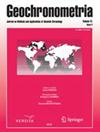鲁中黄土的高分辨率石英OSL和钾长石红外光谱后定年
IF 0.9
4区 地球科学
Q3 Earth and Planetary Sciences
引用次数: 3
摘要
山东中部广泛分布的黄土沉积物是东亚季风变化的敏感记录,地处连接欧亚板块和太平洋的重要区域。然而,由于缺乏高分辨率的年表,人们对古气候变化的详细过程知之甚少。本研究采用石英SAR OSL和钾长石后红外(IR)激发发光(post-IR-IRSL)测年方法,对鲁中黑山黄土古土壤序列进行了年代测定。石英是敏感的,快速成分占主导地位,在~150 Gy(~50 ka)时饱和。测得的钾长石pRIR290-De不依赖于50°C至260°C之间的第一次IR刺激温度。钾长石pIRIR290年龄与高达~75ka的地层一致。在确定研究剖面的时间序列时,选择了50 ka的石英OSL。导出的沉积速率显示出两个相对快速的阶段,古土壤为~32.0±5.5 cm/ka(~11–8 ka),黄土为~54.8±1.1 cm/ka(约34–30 ka)。确定了约30 ka至约17 ka之间的黄土侵蚀间断。我们得出结论,黄土沉积物的pIRIR290适用于~8–75ka期间的样品。本文章由计算机程序翻译,如有差异,请以英文原文为准。
High Resolution Quartz OSL and K-feldspar post-IR IRSL Dating of Loess in the Central Shandong Mountains (Eastern China)
Abstract The loess sediments widely distributed in the Central Shandong Mountains are sensitive records of East Asian monsoon changes for situating in a key region connected to the Eurasian Plate and the Pacific Ocean. However, the detailed processes of palaeoclimatic changes are poorly understood for the lack of high-resolution chronology. In this study, the chronology of Heishan loess palaeosol sequence in the Central Shandong Mountains is investigated using quartz SAR OSL and K-feldspar post-IR infrared (IR) stimulated luminescence (post-IR IRSL) dating method. The quartz is sensitive, fast component dominated and saturate at ∼150 Gy (∼50 ka). The measured K-feldspar pIRIR290 De showed no dependency on the first IR stimulation temperature between 50°C and 260°C. The K-feldspar pIRIR290 ages are consistent with the stratigraphy up to ∼75 ka. In establishing the chronological sequence for the study section, quartz OSL ages <50 ka and the K-feldspar pIRIR290 ages >50 ka were selected. Derived sedimentation rates show two relatively rapid stages of ∼32.0 ± 5.5 cm/ka for the palaeosol (∼11–8 ka) and ∼54.8 ± 1.1 cm/ka for the loess (∼34–30 ka). An erosional hiatus of loess between ∼30 ka and ∼17 ka is identified. We conclude that the pIRIR290 of loess sediments is applicable for samples during ∼8–75 ka.
求助全文
通过发布文献求助,成功后即可免费获取论文全文。
去求助
来源期刊

Geochronometria
地学-地球科学综合
CiteScore
2.20
自引率
0.00%
发文量
1
审稿时长
>12 weeks
期刊介绍:
Geochronometria is aimed at integrating scientists developing different methods of absolute chronology and using them in different fields of earth and other natural sciences and archaeology. The methods in use are e.g. radiocarbon, stable isotopes, isotopes of natural decay series, optically stimulated luminescence, thermoluminescence, EPR/ESR, dendrochronology, varve chronology. The journal publishes papers that are devoted to developing the dating methods as well as studies concentrating on their applications in geology, palaeoclimatology, palaeobiology, palaeohydrology, geocgraphy and archaeology etc.
 求助内容:
求助内容: 应助结果提醒方式:
应助结果提醒方式:


